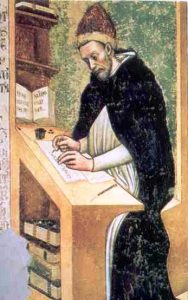QUAERITUR:
Would you like to see the pope (or maybe the next one) resume wearing a red cassock?
Well, this is a truly burning question, isn’t it.
There are conflicting theories about how the pope wound up garbed in white. Some think that Bl. Innocent V, pope for a few months in 1276, kept his white Dominican habit. Others think that it was Pius V, 1566-72, who kept his white Dominican habit. Either way, it seems that Dominicans were involved.
Would I like to see popes in red? No.
What I would like to see is the proper use of traditional papal garb and vestments, which demonstrates humility and shows respect for the office and God’s people.
There is, by the way, a nickname, the Red Pope, for the head of Propaganda Fidei, the Congregation for the Evangelization of Peoples. Back in the day, this was an extremely powerful position, especially because of the massive funds the head of Propaganda controlled and the territories he governed. The “red” here refers to the color of the cardinal’s garb.
However, another “Red Pope” could be the late, great Cardinal Giuseppe Siri, whom some claim was the real pope, truly the one elected in 1958. The story is that Siri was elected as Gregory XVII but because of massive resistance his election was somehow reversed and John XXIII was elected. The Siri Theory is the foundation of the claims of some sedevacantists. Other sedevacantists disputed the 1903 election of Giuseppe Sarto as Pius X. That conclave originally, or nearly so, elected Card. Mariano Rampolla del Tindaro. Back in the day, it was possible for secular powers to influence conclaves. When Rampolla was elected, or nearly so, the Card. Prince-Archbp. of Krakow exercised Franz Joseph’s, the Emperor of Austria’s, veto. One of Pius X’s first official acts was to abolish the veto right, the ius exclusivae, which was the prerogative of the Catholic monarchs of France, Spain, Austria, and the Holy Roman Emperor and exercised through a cardinal of royal blood. This veto had been used against papal candidates some dozen times during the 17th-19th centuries.
Let’s just say that had Siri been elected things would have been very different, as they would have under Rampolla.
Various sedevanctist theories have popped up over the years. There are those who say that the 2013 conclave produced an invalid election for a couple reasons. First, some say there shouldn’t have been a conclave at all because Benedict XVI did not properly abdicate and he remains Pope. Second, some say that, because of the machinations of certain people campaigning to manipulate the outcome of the conclave, thus incurring excommunication, the election was void.
All of this demonstrates how important the figure of the Successor of Peter is, the importance of the Petrine Ministry as a constituent feature which God wove into the very fabric of the one, true, Catholic Church He founded.
Catholics take their popes seriously. However, there have been times in the history of the Church when popes have been take too seriously. There have been great popes and relatively insignificant popes, saintly popes and corrupt popes, influential popes and feckless popes, effective popes and useless popes. God the Holy Spirit does not elect popes, men do. Hopefully the men are inspired by the Holy Spirit. Nevertheless, the role of the Holy Spirit in the election of popes is, at the very least, to avoid total disaster for the Church.



































I’d like to see the pope in a Hawaiian shirt and flip flops, happily retired to the south Pacific without internet access.
;-)
And I’d like to see some bishops in black and white stripes.
I was unaware of the “Royal vetos”. Interesting that St. Pius X’s election supposedly involved one. One of his reforms was to lower the age for receiving First Communion (and also First Penance), moving them ahead of reception of Confirmation.
Just a minor factoid.
Although I would love it to be true, popes were wearing white before St. Pius V. It seems that the first pope presented in a contemporary portrait wearing white is the Della Rovere pope Sixtus IV. Oddly enough a Franciscan. He is so shown in Melozzo da Forlì’s famous painting:
http://www.museivaticani.va/content/museivaticani/en/collezioni/musei/la-pinacoteca/sala-iv—secolo-xv-xvi/melozzo-da-forli–sisto-iv-nomina-bartolomeo-platina-prefetto-de.html
The image of Bl. Innocent V in the post is from the frescos in the Dominican chapter house in Traviso and is from about 1351/2. Sadly, it was a convention to paint Dominican saint bishops and popes in their habit as an iconographic type, so it doesn’t really show us, sadly, what Bl. Innocent actually wore as pope.
“Second, some say that, because of the machinations of certain people campaigning to manipulate the outcome of the conclave, thus incurring excommunication, the election was void.” How would this even be determined/enforced by a future Pope? How would he, if he held this thesis, prove that he was validly elected even when excommunicated and Francis-created Cardinals were taken out of the equation? I understand the frustrations of sedes, especially Francis-only sedes, but they never have good answers for such questions.
“Back in the day, it was possible for secular powers to influence conclaves. ”
One can’t help but wonder if secular powers do not retain influence in our own day, though more obliquely. I’d hate to believe we came up with this all by ourselves.
Gerard Plourde: not”supposed”, it’s a fact that the Austro-Hungarian Emperor did use it in that conclave, and St. Pope Pius X ended it. Thankfully. Apparently, the Cardinal was suspected of freemasonic tendencies. Whatever about that, the Ius Exclusivae was a fact.
I try to remember that, although whoever’s steering the barque of Peter through the storm seems to be veering off course, Jesus is always in the boat with us.
OTOH, I’m not sure it would have been a bad idea for a hypothetical king of France or Austria-Hungary to have been able to prevent the election of say… a Jesuit from the papacy.